Skil 4485 User Manual
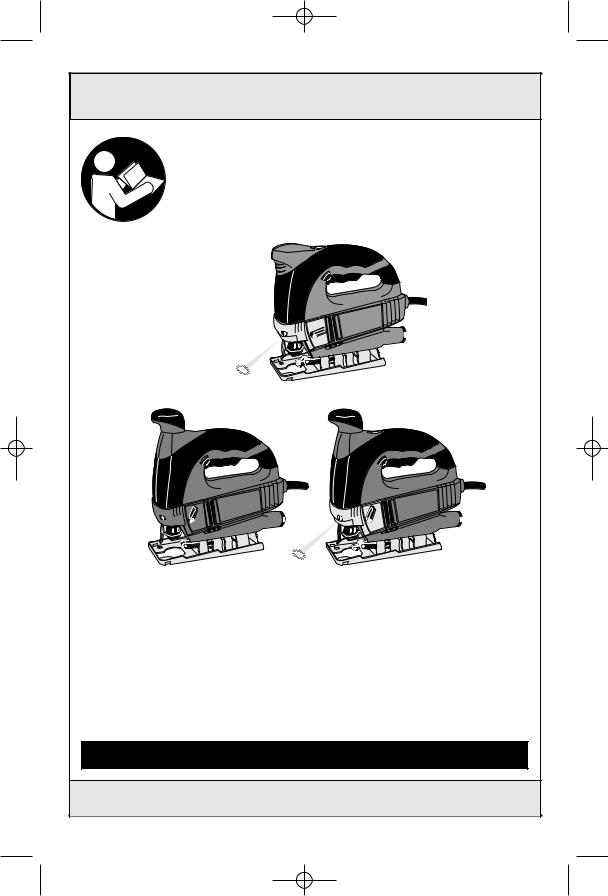
SM 1619X00516 10-04 10/11/04 |
8:36 AM Page 1 |
|
IMPORTANT: |
IMPORTANT : |
IMPORTANTE: |
Read Before Using |
Lire avant usage |
Leer antes de usar |
Operating/Safety Instructions |
||
Consignes de fonctionnement/sécurité |
||
Instrucciones de funcionamiento y seguridad |
||
4480 |
|
|
4485 |
|
|
4540 |
|
|
4580 |
|
|
Call Toll Free |
Pour renseignement des |
Llame gratis para |
for Consumer Information |
consommateurs et centres |
obtener información |
& Service Locations |
de service, appelez au |
para el consumidor y |
|
numéro gratuit : |
ubicaciones de servicio |
1-877-SKIL999 (1-877-754-5999) www.skil.com |
||
For English |
Parlez-vous français? |
¿Habla español? |
See page 2 |
Voir page 14 |
Ver página 26 |

SM 1619X00516 10-04 10/11/04 8:36 AM Page 2
Power Tool Safety Rules
! WARNING Read and understand all instructions. Failure to follow all instructions listed below, may result in electric shock, fire and/or serious personal injury.
SAVE THESE INSTRUCTIONS
Work Area
Keep your work area clean and well lit.
Cluttered benches and dark areas invite accidents.
Do not operate power tools in explosive atmospheres, such as in the presence of flammable liquids, gases, or dust. Power tools create sparks which may ignite the dust or fumes.
Keep by-standers, children, and visitors away while operating a power tool.
Distractions can cause you to lose control.
Electrical Safety
Double Insulated tools are equipped with a polarized plug (one blade is wider than the other.) This plug will fit in a polarized outlet only one way. If the plug does not fit fully in the outlet, reverse the plug. If it still does not fit, contact a qualified electrician to install a polarized outlet. Do not change the plug in any way. Double Insulation



 eliminates the need for the three wire grounded power cord and grounded power supply system. Before plugging in the tool, be certain the outlet voltage supplied is within the voltage marked on the nameplate. Do not use “AC only” rated tools with a DC power supply.
eliminates the need for the three wire grounded power cord and grounded power supply system. Before plugging in the tool, be certain the outlet voltage supplied is within the voltage marked on the nameplate. Do not use “AC only” rated tools with a DC power supply.
Avoid body contact with grounded surfaces such as pipes, radiators, ranges and refrigerators. There is an increased risk of electric shock if your body is grounded. If operating the power tool in damp locations is unavoidable, a Ground Fault Circuit Interrupter must be used to supply the power to your tool. Electrician’s rubber gloves and footwear will further enhance your personal safety.
Don't expose power tools to rain or wet conditions. Water entering a power tool will increase the risk of electric shock.
Do not abuse the cord. Never use the cord to carry the tools or pull the plug from an outlet. Keep cord away from heat, oil, sharp edges or moving parts. Replace damaged cords immediately. Damaged cords increase the risk of electric shock.
When operating a power tool outside, use an outdoor extension cord marked "W-A"
or "W." These cords are rated for outdoor use and reduce the risk of electric shock. Refer to “Recommended sizes of Extension Cords” in the Accessory section of this manual.
Personal Safety
Stay alert, watch what you are doing and use common sense when operating a power tool. Do not use tool while tired or under the influence of drugs, alcohol, or medication. A moment of inattention while operating power tools may result in serious personal injury.
Dress properly. Do not wear loose clothing or jewelry. Contain long hair. Keep your hair, clothing, and gloves away from moving parts. Loose clothes, jewelry, or long hair can be caught in moving parts. Keep handles dry, clean and free from oil and grease.
Avoid accidental starting. Be sure switch is “OFF” before plugging in. Carrying tools with your finger on the switch or plugging in tools that have the switch “ON” invites accidents.
Remove adjusting keys or wrenches before turning the tool “ON”. A wrench or a key that is left attached to a rotating part of the tool may result in personal injury.
Do not overreach. Keep proper footing and balance at all times. Proper footing and balance enables better control of the tool in unexpected situations.
Use safety equipment. Always wear eye protection. Dust mask, non-skid safety shoes, hard hat, or hearing protection must be used for appropriate conditions.
Tool Use and Care
Use clamps or other practical way to secure and support the workpiece to a stable platform. Holding the work by hand or against your body is unstable and may lead to loss of control.
Do not force tool. Use the correct tool for your application. The correct tool will do the job better and safer at the rate for which it is designed.
-2-
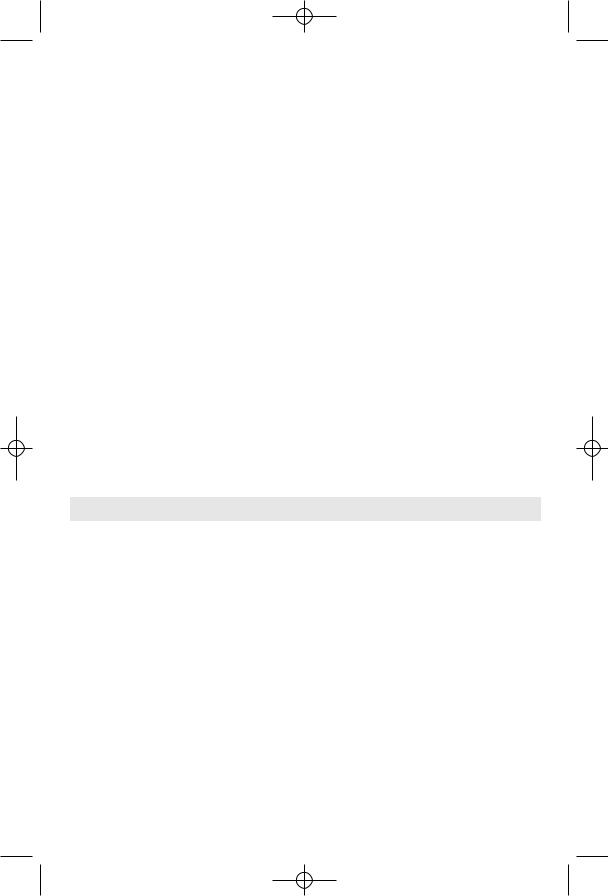
SM 1619X00516 10-04 10/11/04 8:36 AM Page 3
Do not use tool if switch does not turn it “ON” or “OFF”. Any tool that cannot be controlled with the switch is dangerous and must be repaired.
Disconnect the plug from the power source before making any adjustments, changing accessories, or storing the tool.
Such preventive safety measures reduce the risk of starting the tool accidentally.
Store idle tools out of reach of children and other untrained persons. Tools are dangerous in the hands of untrained users.
Maintain tools with care. Keep cutting tools sharp and clean. Properly maintained tools, with sharp cutting edges are less likely to bind and are easier to control. Any alteration or modification is a misuse and may result in a dangerous condition.
Check for misalignment or binding of moving parts, breakage of parts, and any other condition that may affect the tools operation. If damaged, have the tool serviced before using. Many accidents are caused by poorly maintained tools. Develop
a periodic maintenance schedule for your tool.
Use only accessories that are recommended by the manufacturer for your model. Accessories that may be suitable for one tool, may become hazardous when used on another tool.
Service
Tool service must be performed only by qualified repair personnel. Service or maintenance performed by unqualified personnel could result in a risk of injury. For example: internal wires may be misplaced or pinched, safety guard return springs may be improperly mounted.
When servicing a tool, use only identical replacement parts. Follow instructions in the Maintenance section of this manual.
Use of unauthorized parts or failure to follow Maintenance Instructions may create a risk of electric shock or injury. Certain cleaning agents such as gasoline, carbon tetrachloride, ammonia, etc. may damage plastic parts.
Safety Rules for Jigsaws
Hold tool by insulated gripping surfaces when performing an operation where the cutting tool may contact hidden wiring or its own cord. Contact with a "live" wire will make exposed metal parts of the tool "live" and shock the operator. Do not drill, fasten or break into existing walls or other blind areas where electrical wiring may exist. If this situation is unavoidable, disconnect all fuses or circuit breakers feeding this worksite.
Never leave the trigger locked "ON". Before plugging the tool in, check that the trigger lock is "OFF". Accidental start-ups could cause injury.
Be aware of the location and setting of the switch "Lock-ON" button. If the switch is locked "ON" during the use, be ready for emergency situations to switch it "OFF", by
first pulling the trigger then immediately releasing it without pressing the "Lock-ON" button.
Keep hands away from cutting area. Do not reach under the material being cut.
The proximity of the blade to your hand is hidden from your sight.
Keep hands from between the gear housing and saw blade holder. The reciprocating blade holder can pinch your fingers.
Do not use dull or damaged blades. Bent blade can break easily or cause kickback.
Before starting to cut, turn tool "ON" and allow the blade to come to full speed.
Tool can chatter or vibrate if blade speed is too slow at beginning of cut and possibly kickback.
-3-

SM 1619X00516 10-04 10/11/04 8:36 AM Page 4
Always wear safety goggles or eye protection when using this tool. Use a dust mask or respirator for applications which generate dust.
Secure material before cutting. Never hold it in your hand or across legs. Small or thin material may flex or vibrate with the blade, causing loss of control.
Make certain all adjusting screws and the blade holder are tight before making a cut. Loose adjusting screws and holders can cause the tool or blade to slip and loss of control may result.
When removing the blade from the tool avoid contact with skin and use proper protective gloves when grasping the blade or accessory. Accessories may be hot after prolonged use.
Some dust created by ! WARNING power sanding, sawing,
grinding, drilling, and other construction activities contains chemicals known to cause cancer, birth defects or other reproductive harm. Some examples of these chemicals are:
•Lead from lead-based paints,
•Crystalline silica from bricks and cement and other masonry products, and
•Arsenic and chromium from chemicallytreated lumber.
Your risk from these exposures varies, depending on how often you do this type of work. To reduce your exposure to these chemicals: work in a well ventilated area, and work with approved safety equipment, such as those dust masks that are specially designed to filter out microscopic particles.
-4-
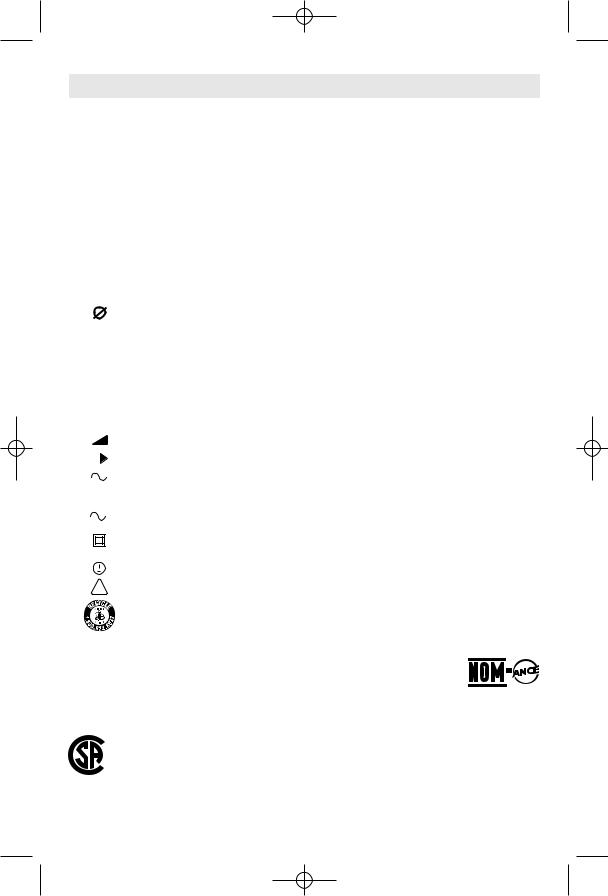
SM 1619X00516 10-04 10/11/04 8:36 AM Page 5
Symbols
IMPORTANT: Some of the following symbols may be used on your tool. Please study them and learn their meaning. Proper interpretation of these symbols will allow you to operate the tool better and safer.
Symbol |
Name |
Designation/Explanation |
||||||||
|
|
|
|
V |
Volts |
Voltage (potential) |
||||
|
|
|
|
A |
Amperes |
Current |
||||
|
|
Hz |
Hertz |
Frequency (cycles per second) |
||||||
|
|
|
W |
Watt |
Power |
|||||
|
|
|
kg |
Kilograms |
Weight |
|||||
|
min |
Minutes |
Time |
|||||||
|
|
|
|
s |
Seconds |
Time |
||||
|
|
|
|
|
|
|
|
|
Diameter |
Size of drill bits, grinding wheels, etc. |
|
|
|
n0 |
No load speed |
Rotational speed, at no load |
|||||
.../min |
Revolutions or reciprocation per minute |
Revolutions, strokes, surface speed, |
||||||||
|
|
|
|
|
|
|
|
|
|
orbits etc. per minute |
0 |
|
|
|
Off position |
Zero speed, zero torque... |
|||||
1, 2, 3, ... |
Selector settings |
Speed, torque or position settings. |
||||||||
I, II, III, |
|
Higher number means greater speed |
||||||||
0 |
|
|
|
|
|
|
Infinitely variable selector with off |
Speed is increasing from 0 setting |
||
|
|
|
|
|
|
|
|
|
Arrow |
Action in the direction of arrow |
|
|
|
|
|
|
|
|
|
||
|
|
|
|
|
|
|
|
|
Alternating current |
Type or a characteristic of current |
|
|
|
|
|
|
|
|
|
Direct current |
Type or a characteristic of current |
|
|
|
|
|
|
|
|
|
||
|
|
|
|
|
|
|
|
|
Alternating or direct current |
Type or a characteristic of current |
|
|
|
|
|
|
|
|
|
||
|
|
|
|
|
|
|
|
|
Class II construction |
Designates Double Insulated |
|
|
|
|
|
|
|
|
|
||
|
|
|
|
|
|
|
|
|
|
Construction tools. |
|
|
|
|
|
|
|
|
|
|
|
|
|
|
|
|
|
|
|
|
Earthing terminal |
Grounding terminal |
|
|
|
|
|
|
|
|
|
||
|
|
|
|
|
|
|
|
|
Warning symbol |
Alerts user to warning messages |
|
|
|
|
|
|
|
|
|
||
|
|
|
|
|
|
|
|
|
||
|
|
|
|
|
|
|
|
|
Ni-Cad RBRC seal |
Designates Ni-Cad battery recycling |
|
|
|
|
|
|
|
|
|
|
program |
|
|
|
|
|
|
|
|
|
|
|
This symbol designates that this tool is listed by Underwriters Laboratories.
This symbol designates that this tool is listed by the Canadian Standards Association.
This symbol designates that this tool is listed to Canadian Standards by Underwriters Laboratories.
This symbol designates that this tool is listed by Underwriters Laboratories, and listed to Canadian Standards by Underwriters Laboratories.
This symbol designates that
this tool complies to NOM Mexican Standards.
-5-

SM 1619X00516 10-04 10/11/04 8:36 AM Page 6
Functional Description and Specifications
! WARNING Disconnect the plug from the power source before making any assembly, adjustments or changing accessories. Such preventive safety
measures reduce the risk of starting the tool accidentally.
Jigsaws
FIG. 1
TOP OF FRONT
HOUSING
“LOCK-ON”
BUTTON
ORBIT CONTROL
LEVER
BUILT-IN WORK LIGHT (Models 4485 & 4580 only)
TOOL-LESS BLADE
CHANGE COVER
SCROLLING KNOB (Models 4540 &4580 only)
“LOCK-ON”
BUTTON
ORBIT/SCROLLING
CONTROL LEVER
BUILT-IN WORK LIGHT (Models 4485 & 4580 only)
TOOL-LESS BLADE
CHANGE COVER
VARIABLE SPEED
CONTROL DIAL (Models 4485 & 4580 only)
RUBBERIZED GRIP
TRIGGER
SWITCH
VENTILATION
OPENINGS
DUST PORT /BLADE
STORAGE
COMPARTMENT
FOOT
DUST BLOWER
SWITCH
VARIABLE SPEED
CONTROL DIAL FIG. 2 (Models 4485 & 4580 only)
RUBBERIZED GRIP
TRIGGER SWITCH
VENTILATION
OPENINGS
DUST PORT /BLADE
STORAGE
COMPARTMENT
FOOT
DUST BLOWER SWITCH
MAXIMUM CAPACITIES
Model |
Blade |
Blade |
Stroke |
|
|
|
No. |
Thickness |
Action |
Length |
Wood |
Aluminum |
Steel |
4480 |
Minimum .7mm - Maximum 1.7mm |
Orbital |
13/16" |
3-1/8" |
1/2" |
1/4" |
4485 |
Minimum .7mm - Maximum 1.7mm |
Orbital |
13/16" |
3-1/8" |
1/2" |
1/4" |
4540 |
Minimum .7mm - Maximum 1.7mm |
Scroll |
13/16" |
3-1/8" |
1/2" |
1/4" |
4580 |
Minimum .7mm - Maximum 1.7mm |
Orbital/Scroll |
13/16" |
3-1/8" |
1/2" |
1/4" |
NOTE: For tool specifications refer to the nameplate on your tool.
-6-
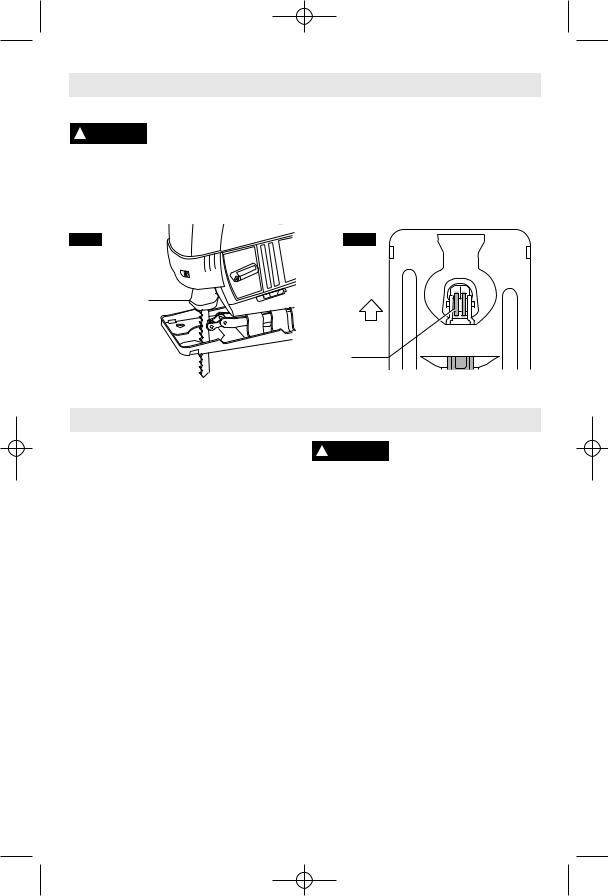
SM 1619X00516 10-04 10/11/04 8:36 AM Page 7
Assembly
Attaching the Blade
! WARNING To prevent personal injury, always disconnect plug from power source before assembling parts, making
adjustments, or changing blades.
1. Insert the saw blade (teeth in cutting direction) until it latches in the plunger (Fig. 3).
FIG. 3
TOOL-LESS
BLADE CHANGE
COVER
When inserting the saw blade, the back of the blade must rest in the groove of the guide roller (Fig. 4).
2. To remove blade, lift tool-less blade change cover up with index finger and thumb and remove blade.
For use with both T or U shank jigsaw blades.
FIG. 4
BLADE

GUIDE ROLLER (Models 4480, 4485 & 4580 only)
Operating Instructions
TRIGGER "ON-OFF" SWITCH (Models 4485 & 4580 only)
TO TURN THE TOOL "ON" squeeze the trigger switch. TO TURN THE TOOL "OFF", release the trigger switch, which is spring loaded and will return to the "OFF" position automatically.
VARIABLE SPEED CONTROLLED
TRIGGER SWITCH (Models 4480 & 4540 only)
Your tool is equipped with a variable speed trigger switch. The tool can be turned "ON" or "OFF" by squeezing or releasing the trigger. The speed can be adjusted from the minimum to maximum nameplate SPM by the pressure you apply to the trigger. Apply more pressure to increase the speed and release pressure to decrease speed (Fig. 1).
"LOCK-ON" BUTTON
The "Lock-ON" button, located in the handle of your tool allows for continuous operation at maximum SPM without holding the trigger (Fig. 1).
TO LOCK TRIGGER "ON": squeeze trigger, depress button and release trigger.
TO UNLOCK THE TRIGGER: squeeze trigger and release it without depressing the "LockON" button.
! WARNING If the “Lock-ON” button is continuously being depressed,
the trigger can not be released.
VARIABLE SPEED DIAL (Models 4485 & 4580 only)
Your tool is equipped with a variable speed dial. The blade stroke rate may be adjusted during cutting operation by presetting the dial on or between any one of the six numbers.
Setting SPM rating (strokes per minute)
1-2 Low stroke
3-4 Medium stroke
5 High stroke Max. Override
ELECTRONIC FEEDBACK CIRCUITRY (EFC) (Models 4485 & 4580 only)
The internal electronic feedback system helps to keep the no load speed virtually constant between no-load and load conditions.
PLUNGER SPEED
The stroke rate may be adjusted as described earlier under “Variable Speed Dial”. The best results for a particular application are determined by experience, though as a general rule, slower speeds are for denser materials and faster speeds are for soft materials.
-7-

SM 1619X00516 10-04 10/11/04 8:36 AM Page 8
BLADE STORAGE COMPARTMENT
Your Jigsaw is equipped with a blade storage compartment in the dust port of your saw (Fig. 5) . To remove, pull compartment out of dust port in direction of arrow.
Always make sure the blade storage compartment is securely in the dust port to prevent blades from falling out.
FIG. 5
DUST
PORT
BLADE
STORAGE
COMPARTMENT
DUST EXTRACTION
Your jigsaw is equipped with a dust port for dust and chip extraction.
To use this feature, remove blade storage compartment and move dust blower switch to the “OFF” position “O” (Fig. 6).
Attach vacuum hose (optional accessory) to the dust port, and connect opposite end of the hose to a shop vacuum cleaner.
|
|
FIG. 6 |
DUST PORT |
|
|
ON= O |
I |
DUST |
BLOWER |
||
OFF= O |
I |
SWITCH |
|
BUILT-IN WORK LIGHT |
|
FIG. 7 |
|
(Models 4485 & 4580 only) |
|
Your tool is also equipped with a light that |
|
turns on automatically when the switch is |
|
activated, for better visibility when cutting |
|
(Fig. 7). |
|
ORBITAL ACTION MODELS
Orbital Action models, have a lever (Fig. 8) that will regulate the orbital action from "Smooth" position for normal up and down motion to maximum orbital action for faster cutting in softer materials.
FIG. 8
ORBIT
CONTROL
LEVER
To increase orbital action, turn the lever to a higher setting. To decrease orbital action turn ever to a lower setting. When minimal splintering is desired we recommend using "Smooth" position.
SMOOTH |
LOW / MED |
FAST |
MILD STEEL / SOFT METALS |
METAL PLASTIC |
SOFT WOODS |
ALL MATERIALS |
HARD WOODS |
PLYWOOD |
ATTENTION: In order to achieve orbital action, the blade must be facing STRAIGHT FORWARD and the back of the blade must rest in the groove of the guide roller, and the
foot must be all the way in the forward position. To adjust foot, lift foot adjustment lever and flip lever completely over, then push foot forward as far as possible and lower foot adjustment lever to maintain adjustment (Fig. 9).
Orbital cut control is not observable when jigsaw is free running. Jigsaw must be cutting for orbital action to occur. The speed of cut is much more apparent in thicker materials such as 2 by lumber.
FIG. 9
FOOT
BLADE
GUIDE
ROLLER
FOOT
ADJUSTMENT
LEVER
-8-

SM 1619X00516 10-04 10/11/04 8:36 AM Page 9
SCROLL MODELS (4540 & 4580 only)
Scrolling saws permit 360˚ rotation of the saw blade without turning the saw, so intricate designs may be cut with minimum effort. To permit rotation of plunger turn lever, (Fig. 10)
FIG. 10
HANDLE
SCROLLING
KNOB
LEVER
to scrolling. The plunger of your scrolling saw can also be locked in (4) positions, 90˚ apart. ATTENTION: When scroll cutting the blade must be moved away from the guide rollers. (Always move foot completely back). To adjust foot, lift foot adjustment lever and flip lever completely over, then push foot backwards as far as possible to engage
locking tab, then lower the foot adjustment lever to maintain adjustment (Fig. 11).
Note: It may be necessary to turn scrolling knob slightly back and forth to be sure the plunger is locked in the desired position.
When manually scroll cutting, operate saw by holding the handle with one hand and rotating the scrolling knob manually with your free hand.
! CAUTION Excessive side pressure to the blade could result in
broken blades and/or damage to the material being cut.
Note: When scroll cutting intricate designs, we recommend using a scroll cutting blade. However, a standard blade can be used.
FIG. 11
BLADE
FOOT
GUIDE
ROLLER
Cutting Tips
Face the good side of the material down and secure it in a bench vise or clamp it down. Draw cutting lines or designs on the side of the material facing up towards you. Then place the front edge of the saw foot on the work and line up the blade with the line to be cut. Hold the jigsaw firmly, turn it on, and press down (to keep the saw foot flat against the work) as you slowly push the saw in the direction of the cut.
Build up cutting rate gradually, cutting close to the line (unless you want to leave stock for finish sanding). As you cut you may have to adjust or relocate the vise or clamps to keep the work stable. Do not force the saw or the blade teeth may rub and wear without cutting and the blade may break. Let the saw do most of the work. When following curves, cut slowly so the blade can cut through cross grain. This will give you an accurate cut and will prevent the blade from wandering.
CUTTING WITH A STRAIGHTEDGE
Always use a rough cut blade when possible. Clamp a straightedge on the work parallel to the line of cut and flush with the side of the saw foot. (Either first mark the line of cut and
then position the straightedge parallel and at the same distance as between the blade and the side edge of the foot or first mark the side edge of the foot and then clamp the straightedge on the mark and parallel to the cut line Fig. 12).
On models with the scroll feature, it is advised to lock scroller knob.
As you cut, keep the saw foot edge flush against the straightedge and flat on the workpiece (Fig. 12).
FIG. 12 |
FOOT |
|
AGAINST |
|
STRAIGHT- |
|
EDGE |
LINE
OF
CUT
 CLAMPS
CLAMPS
-9-
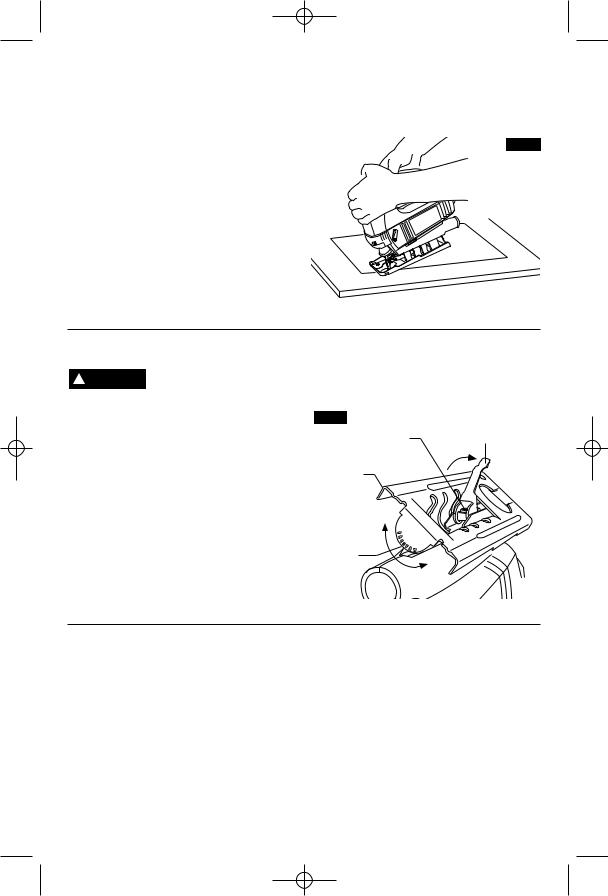
SM 1619X00516 10-04 10/11/04 8:36 AM Page 10
PLUNGE CUTTING
Plunge cutting is useful and time-saving in making rough openings in softer materials. It is not necessary to drill a hole for an inside or pocket cut. Draw lines for the opening, hold the saw firmly, tilt it forward so that the toe of the saw foot rests on the work, but with the blade well clear of the work. Start the motor, and then very gradually lower the blade. When it touches, continue pressing down on the toe of the saw foot slowly pivoting the saw like a hinge until the blade cuts through and the foot rests flat on the work. Then saw ahead on the line of cut line. We do not recommend plunge cutting with a scroll blade (Fig. 13).
To make sharp corners, cut up to the corner, then back up slightly before rounding the
corner. After the opening is complete, go back to each corner and cut it from the opposite direction to square it off. Do not try to plunge cut into hard materials such as steel.
FIG. 13
 TOE OF FOOT
TOE OF FOOT
BEVEL OR ANGLE CUTTING
! WARNING To prevent damage to the tool when bevel or angle
cutting, the scroll mechanism must be locked in place with the cutting edge of the blade facing the front of the tool.
Disconnect the cord from the power source. The foot can be adjusted to cut any angle from 0˚ to 45,˚ and is equipped with quick reference detent stops at 0˚, 15˚, 30˚, and 45˚.
TO ADJUST: Lift foot adjustment lever in the bottom of foot as shown, move foot slightly backward to disengage the locking tab (Fig. 14).
Position foot to desired angle, then push forward to engage locking tab and lower adjustment lever to maintain adjustment. After adjusting foot make a sample cut to check the angle, (Fig. 14).
Note: If the foot becomes loose you can use a screwdriver to tighten screw located on the foot adjustment lever, then re-adjust the foot adjustment lever.
FIG. 14 |
|
FOOT |
|
|
ADJUSTMENT |
SCREW |
|
LEVER |
|
|
|
FOOT |
|
|
45 |
|
|
30 |
|
|
15 |
|
|
0 |
|
|
15 |
30 |
45 |
|
||
LOCKING |
|
|
TAB |
|
|
METAL CUTTING
When cutting metal clamp material down. Be extra certain that you move the saw along slowly. Use lower speeds. Do not twist, bend, or force the blade. If the saw jumps or bounces, use a blade with finer teeth. If the blade seems clogged when cutting soft metal, use a blade with coarser teeth.
For easier cutting, lubricate the blade with a stick of cutting wax, if available, or cutting oil when cutting steel. Thin metal should be
sandwiched between two pieces of wood or tightly clamped on a single piece of wood (wood on top of the metal). Draw the cut lines or design on the top piece of wood.
When cutting aluminum extrusion or angle iron, clamp the work in a bench vise and saw close to the vise jaws.
When sawing tubing and the diameter is larger than the blade is deep, cut through the wall of the tubing and then insert the blade into the cut rotating the tube as you saw.
-10-
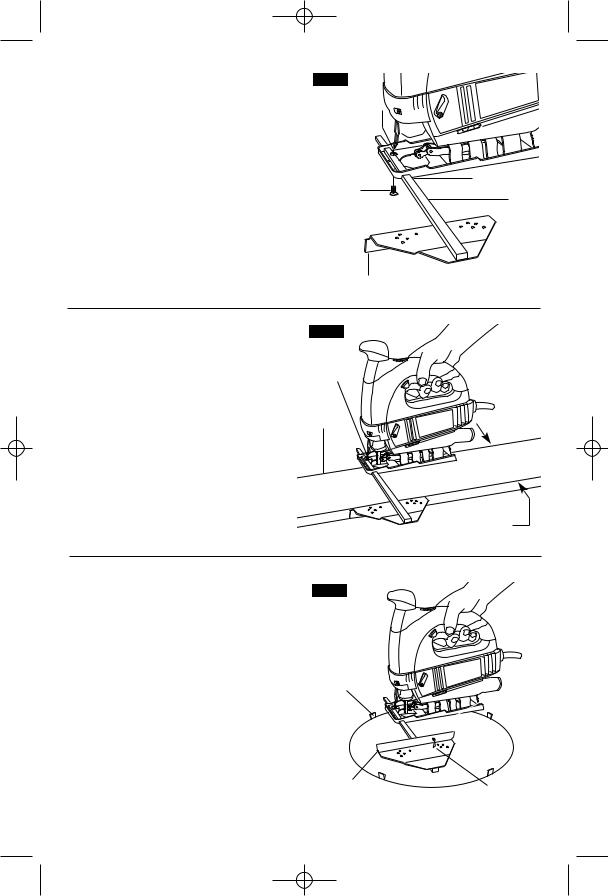
SM 1619X00516 10-04 10/11/04 8:36 AM Page 11
RIP FENCE AND CIRCLE CUTTING GUIDE
This accessory is available at an extra cost. It is used for fast and accurate straight and circle cutting (Fig. 15).
ATTACHING RIP FENCE
1.Insert bar of rip fence through the slots provided in foot, from either side of foot with the edge guide facing down (Fig. 15).
2.Thread the clamp screw from under the foot through the threaded hole in the clamp on left side of foot, and securely tighten clamp screw with a screwdriver, to clamp the rip fence bar in place.
FIG. 15
CLAMP 


CLAMP |
SLOT |
|
|
SCREW |
BAR |
EDGE GUIDE DOWN
STRAIGHT CUTTING
Once the rip fence is attached, measure from the edge of work to the line of cut, and set edge guide of rip fence to the same distance and then securely tighten clamp screw (Fig. 16).
FIG. 16
CLAMP SCREW
LINE
OF CUT
DESIRED
WIDTH
CIRCLE CUTTING
1.Before attaching the rip fence, draw a circle and drive a finishing nail in the center of circle.
2.Drill or plunge cut near the circles edge, turn saw off and disconnect the plug from power source (Fig. 17).
3.Attach rip fence to saw with the edge guide facing UP. In order for the rip fence to cut a circle, the nail must be in alignment with the blade, as shown in (Fig. 18).
4.Measure the distance from the selected hole to the blade to be equal to the circle radius.
5.Insert plug into power source, hold the saw firmly, squeeze trigger and slowly push the
FIG. 17
WEDGE
EDGE
GUIDE UP
FINISHING
NAIL
-11-

SM 1619X00516 10-04 10/11/04 8:36 AM Page 12
FIG. 18
BLADE MUST BE IN
ALIGNMENT WITH NAIL
saw forward. To make a hole, cut from inside the circle; To make wheels or discs, cut from the outside.
Cutting Tip: Cut slowly so the blade will stay straight in the cut. Place small wedges in the cut as shown in Fig. 17, to keep the inner
circle from spreading when near the end of the cut.
NAIL
-12-
